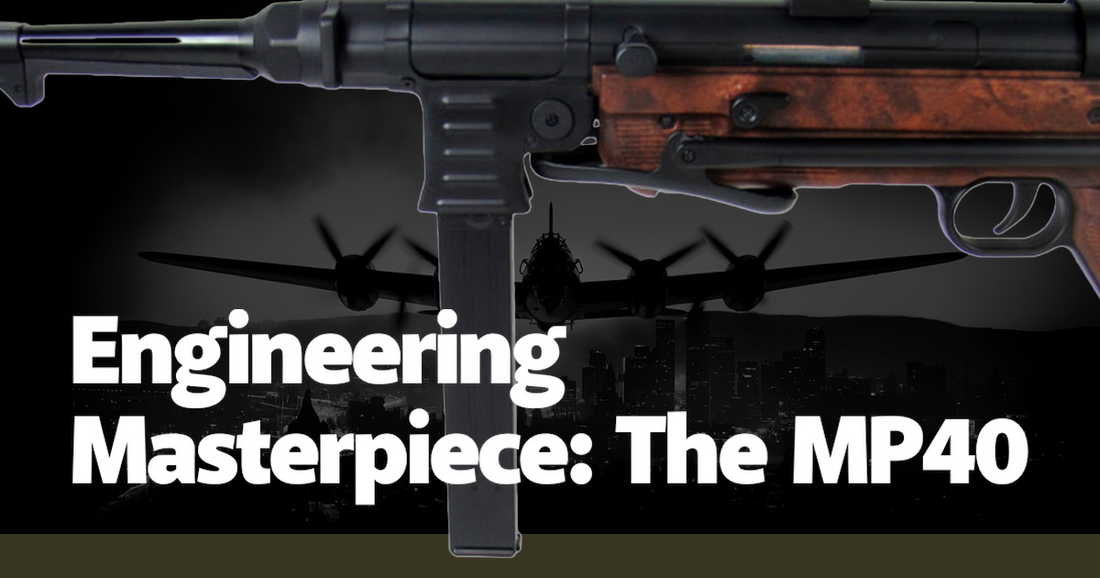The MP40, often referred to by its full name, the Maschinenpistole 40, stands as an engineering marvel from the tumultuous years of World War II. This submachine gun, developed by the Germans, was not merely a weapon but a symbol of mechanical ingenuity and battlefield efficiency. The MP40's sleek, utilitarian design belied its deadly effectiveness, making it a favorite among soldiers and a feared adversary for those on the receiving end of its firepower. Crafted predominantly from stamped steel and Bakelite, the MP40 was not just a product of necessity but a testament to German engineering prowess during a time of intense conflict.
The MP40's development was spearheaded by Heinrich Vollmer, an engineer who sought to create a weapon that was both reliable and easy to produce. Vollmer's vision was realized in the MP40, which featured a telescoping bolt system that reduced the weapon's overall length and allowed for better maneuverability in tight quarters. This was particularly advantageous in urban combat, where soldiers often found themselves fighting in confined spaces. The MP40's folding stock further enhanced its portability, making it a versatile tool for infantrymen who needed to move quickly and efficiently.
One of the most remarkable aspects of the MP40 was its rate of fire. Capable of firing approximately 500 to 550 rounds per minute, the MP40 struck a balance between firepower and control. This rate of fire was ideal for suppressive fire and close-quarters combat, where precision was less important than the ability to lay down a continuous stream of bullets. The 9mm Parabellum cartridge used by the MP40 was also a key factor in its success. This cartridge was widely available and provided a good balance between stopping power and recoil, making the MP40 manageable even for less experienced soldiers.
The MP40's impact on the battlefield was profound. Anecdotes from veterans often highlight the weapon's reliability under harsh conditions. One such story comes from a German soldier who recounted how his MP40 continued to function flawlessly even after being submerged in water and caked with mud. This level of reliability was crucial in the unpredictable environments of World War II, where equipment failure could mean the difference between life and death. The MP40's robustness earned it a reputation as a dependable companion in the heat of battle.
The psychological impact of the MP40 should not be underestimated. Its distinctive sound became synonymous with the presence of German forces, striking fear into the hearts of Allied soldiers. The MP40's design also contributed to its intimidating appearance. The weapon's sleek, almost futuristic look was a stark contrast to the more traditional firearms used by many other nations at the time. This combination of form and function made the MP40 not just a tool of war, but a symbol of the technological edge that Germany sought to maintain throughout the conflict.
Despite its many advantages, the MP40 was not without its flaws. The weapon's magazine, which held 32 rounds, was prone to jamming if not properly maintained. This issue was exacerbated by the fact that soldiers often loaded the magazines to full capacity, which increased the likelihood of malfunctions. Additionally, the MP40's effective range was limited to about 100-150 meters, making it less suitable for long-range engagements. However, these shortcomings were relatively minor compared to the weapon's overall performance and ease of use.
The legacy of the MP40 extends beyond World War II. Its influence can be seen in the design of subsequent submachine guns, such as the Uzi and the American M3 Grease Gun. The principles of simplicity, reliability, and ease of manufacture that guided the development of the MP40 have become cornerstones in the field of small arms design. Even today, the MP40 is studied by military historians and firearms enthusiasts who appreciate the ingenuity and craftsmanship that went into its creation.
In conclusion, the MP40 is more than just a piece of military hardware; it is an engineering masterpiece that exemplifies the blend of form and function. Its development, performance, and legacy offer a window into the technological and tactical innovations of World War II. The MP40's enduring reputation is a testament to its effectiveness and the skill of the engineers who brought it to life. As we look back on the history of military technology, the MP40 stands out as a shining example of how engineering excellence can shape the course of history.

